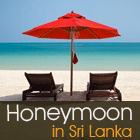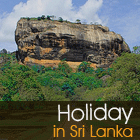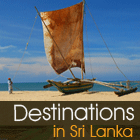Sri Lanka - Travel Destinations
Sinharaja Tropical Rain Forest

The Sinharaja tropical rain forest
The Sinharaja tropical rain forest, bounded by rivers on three sides, is the most important lowland rainforest situated in the Southwest of Sri Lanka. It is a primeval forest and a biodiversity hotspot in Sri Lanka, and has been declared a Biosphere Reserve and World Heritage Site by UNESCO. Containing an area of 88.64 km2 (8864 hectares) it extends over parts of the Sabaragamuwa and Southern Provinces of Sri Lanka and is a veritable treasure house of endemic flora and fauna. Isolated from the Indian mainland for thousands of years, the rain forests of Sri Lanka, in particular the Sinharaja rain forest, have produced a number of plant and animal species endemic to the island. The dense forest of the Sinharaja contains over 150 species of trees A striking feature is the height of the dominant trees with some rising even up to 50m. 20 out of 26 endemic birds of Sri Lanka are found here. A large proportion of the flora found in the Sinharaja is endemic to the country and some endemic to the forest itself. It also harbors more than 50% of Sri Lanka’s endemic mammals, birds, butterflies, reptiles and amphibians. An attractive feature is the wide variety of mixed species of foraging birds. Nearly 100 such flocks have been observed with some flocks containing as many as 48 species. Sri Lanka is reputed to possess the highest density of amphibian species in Lanka. Discoverbudget tour packages in Sri Lanka andbudget hotels in Sri Lanka.
The terrain consists of a series of ridges and valleys, and the altitude ranges from 300 – 1170m.There are a number of prominent peaks within the reserve with the highest at a height of 1171m. The forest is an important watershed and many streams feeding major rivers like Kalu Ganga and Gin Ganga arise from within the Sinharaja region. As Sri Lanka’s only remaining primary tropical rain forest, Sinharaja “is a living repository of a pristine ecosystem” Discover Sri Lanka. Contact tour agent in Sri Lanka and find out abouttour packages in Sri Lanka andhotels in Sri Lanka.
Birds
Sinharajahas an impressive Bird life with 147 species on record. Among the birds found in Sinharaja are the following:
Sri Lanka Wood Pigeon
Included among endangered birds the Sri Lanka Wood Pigeon is an endemic resident breeding bird. It has a dark grey tail and upper part with the head and under part lilac, with black and white squares on the nape. It is 36cm in length and in the mating season emits an owl like hoot. When youtour in Sri Lanka during your Sri Lanka holiday find cheap hotels in Sri Lanka and cut down your expenses.
Sri Lanka Grey Hornbill
The Sri Lanka Grey Hornbill is an endemic resident breeder. It is a large gregarious bird 45cm in length. Its wings and back are grey and the crown is brown color. It has a long blackish tail with white sides and under part, and a long curved bill. Male has a cream colored bill, female black with a cream stripe.
Red - faced Malkoha
Red-faced Malkoha, a member of the cuckoo order, is endemic to Sri Lanka. It is a large bird 46cm in length with a long tail. Its back is dark green and the belly is white. It has a large red patch around the eye. The sexes are similar. Feeds mostly on insects. It is largely confined to the Sinharaja forest. It is also found among the mixed species foraging flocks of the Sinharaja and is classified as vulnerable. Enjoy your wedding and honeymoon in Sri Lanka.
Green billed Coucal
Green billed Coucal, considered the rarest of Sri Lankan birds, is a member ofthe cuckoo order andis endemic to Sri Lanka. It is a very elusive bird. It is 43cm in length. The head and body are purple-black, the wings maroon, tail long and dark green, and the bill light green. Sexes are similar. Favorite food snails. It is considered a vulnerable species. Enjoy aholiday in Sri Lanka. Discoverbudget tour packages in SriLanka andbudget hotels in Sri Lanka.
Sri Lanka Sri Lanka Spurfowl, a member of the pheasant family,is a very secretive bird endemic to the dense rainforests of Sri Lanka. It is a ground nesting bird 37cm in length. The female has plain brown back and wings. Male has striking black and white plumage and crimson red legs. Both sexes have a whitish throat. The legs have two long spurs and hence the name. It is classified as Least Concern(LC) Plan your Sri Lanka tour in advance.
Sri Lanka Junglefowl
Sri Lanka Jungle fowlis a member of the pheasant family and is endemic to Sri Lanka. It is also the national bird of Sri Lanka. It is a large bird. The male is 66 -73cm in length and has colorful plumage. It has an orange-red body and dark purple wings and tail; back of the head and neck are golden; it has a red comb with yellow center. The female is smaller at only 35cm, mainly brown with white markings on belly and breast.
Sri Lanka Blue Magpie
Sri Lanka Blue Magpieis a member of the crow family and endemic toSri Lanka. Usually found in small groups of 6-7 it is 42-47cm in length. Blue in color it has a chestnut head and wings, and a long blue tail with white tip; the legs and bill are red. It is classified as a vulnerable species.Discover Sri Lanka. Contact tour agent in Sri Lanka and find out abouttour packages in Sri Lanka andhotels in Sri Lanka.
Spot winged Thrush
Spot winged Thrushis an endemic resident breeder in Sri Lanka and is classified as Near Threatened. It has a rich and varied whistling song. Generally a solitary bird quite secretive . Eats more insects than fruit . Adult is 27cm in length with light brown back; under parts are white with heavy spotting; has yellow legs and black bill.
Jungle Shrew
Jungle Shrewis a mammal in the Soricidae family andis endemic to Sri Lanka. It is threatened by habitat loss and is considered an endangered species. Its occupancy area is considered to be less than 500km2 It is a nocturnal terrestrial shrew facing a high risk of extinction.
Fulvus Roundleaf Bat
Fulvus Roundleaf Batis a small bat weighing between 8-10gm.Body length 43mm; tail length between 25-29mm; wingspan 130mm. Found in colonies ran- ging from 10-100 individuals. Breeds annually in November. This bat does not venture far from roosting site when hunting at night in groups of 4 or 5. Feeds on insects . Listed as a species of Least Concern .Plan your Sri Lanka tour in advance
Purple -faced Langur
Purple-faced Languris a species of Old World monkey endemic to Sri Lanka. Brown in appearance with a long tail and purple upper face . Classified as Endangered . Found in small and scattered groups. Subsists mostly on leaves but also eats fruits and seeds. Loud calls- a harsh bark or a whoop- are more often heard in the morning. Enjoy yourwedding and honeymoon in Sri Lanka.
Golden Palm Civet
Golden Palm Civet is endemic to Sri Lanka and is classified as Vulnerable. There are two morphs of this mammal recorded in Sri Lanka - one dark brown and the other golden. It is a solitary nocturnal creature and subsists on fruits, invertebrates and small vertebrates.
Lyard's Palm Squirrel
Layard's Palm Squirrelis a species of rodent endemic to Sri Lanka. It is classified as vulnerable. It is restricted to a few fragmented locations and is a diurnal and arboreal species.
Travancore Flying Squirrel
Travancore Flying Squirrel is listed as a Near Threatened species and is a small solitary arboreal and nocturnal animal living 15-20m in tree canopies. It is endemic to Sri Lanka and is a smaller cousin of the Large Flying Squirrel.
Nature trails of Sinharaja Rain Forest
There are two main nature trails namely Sinhagala and Mulawella nature trails.
Sinhagala Nature Trail - From Kudawa Conservation Center, Weddagala, Kalawana starting at an altitude of 300m it extends about 2.5 km to Sinhagala summit at an altitude of 473m and takes 5-7 hours.
Mulawella Nature Trail – From Kudawa Conservation Center, Weddagala, Kalawana , starting at an altitude of 457m it goes 2.5 km to Mulawella summit, altitude 758m, and takes 1-2 hours.
Best months to hike are December – April.
Importance of Sinharaja Rain Forest to Foreign Tourists
Sinharaja is one of the few virgin rain forests remaining in the world and there is no end to what may be discovered during a rainforest exploration in Sri Lanka. It is the only undisturbed rain forest left in Sri Lanka and contains many species of flora and fauna found nowhere else in the world. If these species are allowed to become extinct it would be an irreparable loss for the entire world. Therefore, it is the responsibility of all humanity to promote the conservation of this World Heritage Site .When youtour in Sri Lanka during your Sri Lanka holiday find cheap hotels in Sri Lanka and cut down your expenses.




